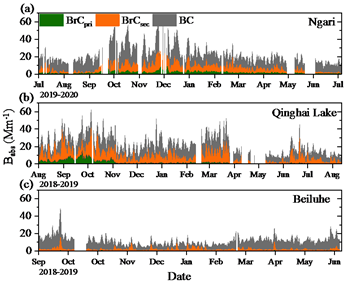Black carbon (BC), brown carbon (BrC) are important light-absorbing aerosol. Black carbon (BC) and brown carbon (BrC) from the surrounding area can reach the Tibetan Plateau (TP) and influence climate change and glacial melting.
To date, the simultaneous measurements and investigations of BC, primary brown carbon (BrCpri), and secondary brown carbon (BrCsec) in different locations are scarce over the TP because of the high altitude and extremely harsh environment.
A study led by Dr. ZHU ChongShu from Institute of Earth Environment of the Chinese Academy of Sciences, provided a new insight into the temporal-spatial characteristics and effects of BC and BrC over the remote TP.
The measurements were conducted at the northeastern TP site (Qinghai lake, 37.04°N, 99.74°E, 3200 m a.s.l.), the central TP site (Beiluhe, 34.82°N, 92.93°E, 4659 m a.s.l.), and the southwestern TP site (Ngari, 32.50°N, 80.10°E, 4360 m a.s.l.), respectively.

Fig.1 Locations of the sampling sites, including Qinghai Lake, Beiluhe, and Ngari.(Image by ZHU, et)
The apportionments of BC, BrCpri, and BrCsec light absorption were disentangled for wavelengths in the northeastern, central and southwestern TP. BC was the dominant spectral light absorbing carbonaceous component with the percentages of 65%, 56%, and 82% in Ngari, Qinghai Lake, and Beiluhe, respectively.
The enhanced contributions of BrCsec (370 nm) were observed with 27% (Ngari), 34% (Qinghai Lake), and 16% (Beiluhe) of total absorption, which indicated the importance of BrCsec in the TP, especially in the northeastern and southwestern areas. The relative radiative forcings of BrCsec to those of BC were much higher than BrCpri in the range of ultraviolet.

Fig. 2 Light absorption of the BC, BrCpri, and BrCsec at 370 nm in Ngari, Qinghai Lake, and Beiluhe, respectively. (Image by ZHU, et)
Major potential source distributions of BC and BrCpri were identified, which included the pollution bands along the Indo-Gangetic Plain, the pollution zone in the northwestern China, and the interior of the TP.
This work facilitated the understanding of the temporal-spatial characteristics and effects of BC and BrC. Considering the potential effects on environment and climate, the research of BrCpri, and BrCsec properties (formation mechanism and photobleaching, etc.) should receive special attention in the remote TP.

Fig. 3 The trajectory clustering and the map of CWT-BC and CWT-BrCpri, (a) the trajectory clustering and CWT-BC map for Ngari, (b) the CWT-BrCpri map for Ngari, (c) the trajectory clustering and CWT-BC map for Qinghai Lake, (d) the CWT-BrCpri map for Qinghai Lake, (e) the trajectory clustering and CWT-BC map for Beiluhe, and (f) the CWT-BrCpri map for Beiluhe. (Image by ZHU, et)
The study, published in Geophysical Research Letters, , was funded by the Second Tibetan Plateau Scientific Expedition and Research Program (STEP), Grant 2019QZKK0602, and the National Natural Science Foundation of China (41771518).
Contact: Bai Jie, Institute of Earth Environment, Chinese Academy of Sciences, Xi'an, China. Email: baijie@ieecas.cn
 © 2015 Institute of Earth Environment,CAS
© 2015 Institute of Earth Environment,CAS Address:No. 97 Yanxiang Road, Xi'an 710061, Shaanxi, China

 Location :
Location :